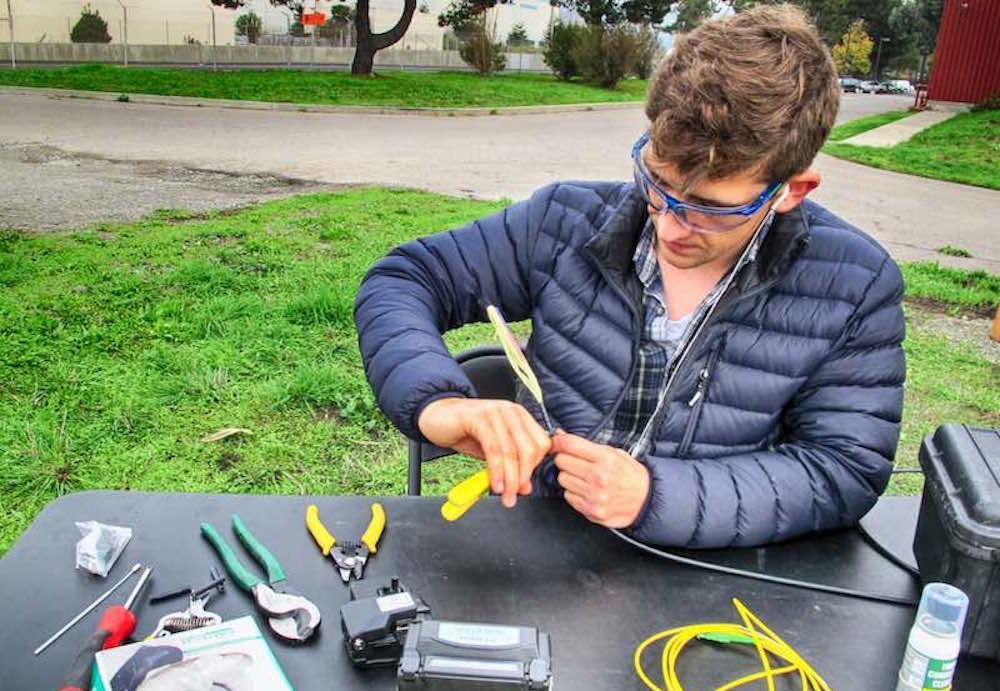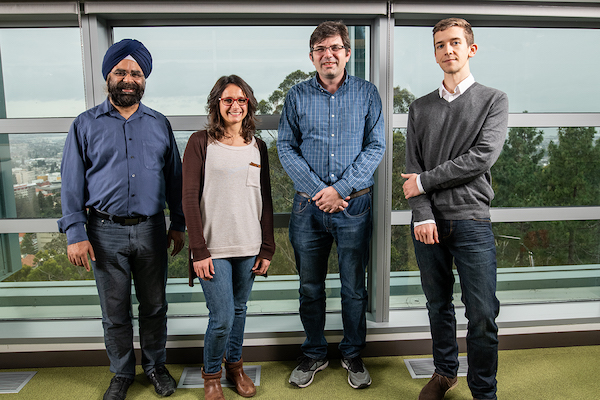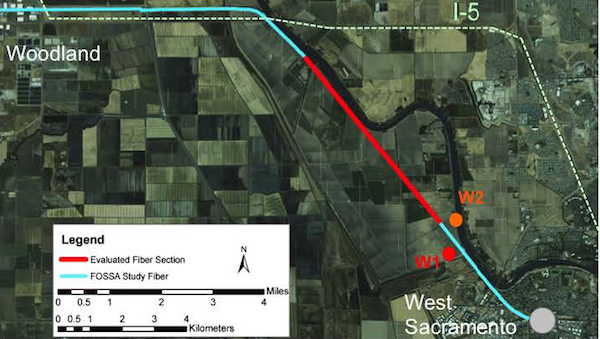
[Image above] UC Berkeley graduate student Nate Lindsey trims fiber-optic cables at the Richmond Field Station in California. Berkeley Lab researchers showed “dark fibers,” unused fiber-optic cables, could be co-opted to serve as earthquake monitoring sensors. Credit: Jonathan Ajo-Franklin, Berkeley Lab
With the United States government shutdown over for the moment, various science agencies including NASA, NIST, and NSF are working to get back on their feet. For these agencies, resuming activities does not just mean rescheduling missed appointments and meetings—it also means implementing legislation passed or reauthorized shortly before the shutdown went into effect.
One area that was the focus of quite a few bills at the end of the last Congress and appears poised to continue receiving attention this year is natural hazards legislation. Specifically, the Natural Earthquake Hazards Reduction Program (NEHRP) Reauthorization Act.
The NEHRP Reauthorization Act was signed into law December 11 and represents the first time Congress provided new statutory direction since 2004 for NEHRP, an interagency program that coordinates and improves research, monitoring, and mitigation efforts concerning earthquakes. In the reauthorization, Congress codified the program’s shift in emphasis away from earthquake prediction to developing early warning systems—such as ShakeAlert—and building community resilience.
An early warning system is more than just a text message popping up on your phone a few seconds become tremors begin to hit. For you to receive a text message, the early warning system must first receive alerts from an array of underground sensors that detect tremors heading your way. However, the process of developing and installing brand new sensors costs tens of thousands of dollars. For the ShakeAlert system mentioned above, the system calls for 1,700 seismic stations estimated to cost just over $38 million!
If only there was already an interconnected, underground system of sensors just lying around that could be commandeered for seismic monitoring. Sound a bit farfetched? Lawrence Berkeley National Laboratory researchers probably thought so too—until they began experimenting with dark fiber.

Dark fiber refers to thousands of miles of fiber-optic cables that lay unused underground, crisscrossing the entire United States. During the 1990s, telecommunications companies rushed to install fiber-optic cables, but they finished just as data transmission technology significantly improved, meaning far fewer cables were needed than had been laid. Today, parts of the dark-fiber network are leased to businesses and companies who want to operate their own fiber-optic network.
At Lawrence Berkeley National Laboratory, a team led by Berkeley Lab researcher Jonathon Ajo-Franklin tested the possibility of co-opting the vast dark-fiber network for “distributed acoustic sensing” of seismic waves. Distributed acoustic sensing (DAS) is a sensing system that uses fiber-optic cables to measure strain and relies on fiber-optic cables’ high sensitivity to deformations.
In 2017, the Berkeley Lab researchers published two papers: an open-access paper demonstrating their ability to combine DAS with novel processing techniques, and a follow-up paper demonstrating validity of DAS compared to conventional seismometers. This year, they published their results concerning DAS tests on a 27-km (17-mi) segment of the 13,000-mi-long dark fiber testbed owned by DOE Energy Sciences Network (ESnet). And their results are encouraging.
“The coverage of the ESnet Dark Fiber Testbed provided us with subsurface images at a higher resolution and larger scale than would have been possible with a traditional sensor network,” says co-author Verónica Rodríguez Tribaldos, a postdoctoral researcher in Ajo-Franklin’s lab, in a Berkeley Lab news release. “Conventional seismic networks often employ only a few dozen sensors spaced apart by several kilometers to cover an area this large, but with the ESnet Testbed and DAS [distributed acoustic sensing], we have 10,000 sensors in a line with a two-meter spacing.”

After recording data for seven months, the Berkeley Lab researchers showed the collected data provided many more benefits beyond just seismic monitoring. “Just by listening for 40 minutes, this technology has the potential to do about 10 different things at once,” Ajo-Franklin says in the news release. Not only could the researchers distinguish between a car or train versus an earthquake, they could characterize soil quality, provide information on aquifers, and detail long-term changes in groundwater and permafrost melt, among others.
The downside to the proliferation of uses, though, is finding ways to effectively manage and process all that data. In the seven months of data recording, the researchers generated 300 terabytes of raw data! (For an idea of just how much data that is, take a look at this article, which describes 300 terabytes in terms of Gmail accounts and Blu-ray discs.)
Unfortunately, ESnet’s dark fiber testbed cannot be completely devoted to seismic monitoring (it is, after all, meant for testing next-generation internet in a production-like environment). However, demonstrating that dark fibers can monitor earthquakes opens up a whole host of possibilities. ESnet owns only one section of the thousands of miles of cable in the dark-fiber network—maybe NEHRP can help acquire some of that network specifically for monitoring earthquakes!
The two 2017 papers, published in Scientific Reports (open-access) and Geophysical Research Letters, are “Distributed acoustic sensing for seismic monitoring of the near surface: A traffic-noise interferometry case study” (DOI: 10.1038/s41598-017-11986-4) and “Fiber-optic network observations of earthquake wavefields” (DOI: 10.1002/2017GL075722).
The 2019 open-access paper, published in Scientific Reports, is “Distributed acoustic sensing using dark fiber for near-surface characterization and broadband seismic event detection” (DOI: 10.1038/s41598-018-36675-8).
